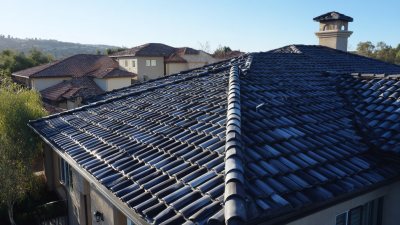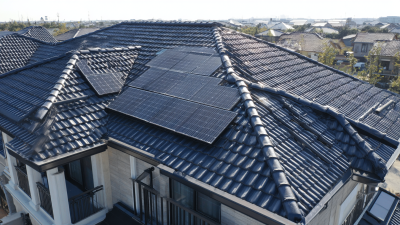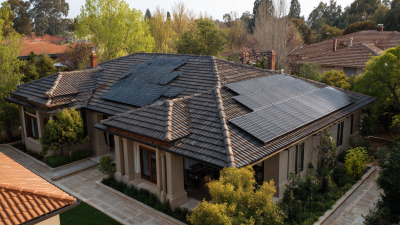How to Maximize Efficiency with Solar Thermal Panels in Your Home
As homeowners increasingly seek sustainable energy solutions, solar thermal panels have emerged as a highly efficient technology for harnessing solar energy for domestic hot water and heating purposes. According to the International Energy Agency, the global solar thermal market has seen a steady growth of approximately 10% annually over the past decade, driven by rising energy costs and increased government incentives for renewable energy investments. These panels can provide up to 70% of a household's hot water needs, significantly reducing reliance on traditional energy sources. This ultimate guide aims to equip homeowners with essential strategies and best practices to maximize the efficiency of solar thermal panels, ultimately leading to reduced energy bills and a lower carbon footprint. Embracing this innovative technology not only enhances home energy efficiency but also contributes to a sustainable future.

Understanding the Basics of Solar Thermal Panels and Their Benefits
 Solar thermal panels are a sustainable energy solution that harnesses the sun's energy to provide heating for residential use. Unlike photovoltaic panels that generate electricity, these systems convert sunlight directly into thermal energy, which can be used to heat water for domestic use, like showers, dishwashing, or even swimming pools. This technology is straightforward and typically consists of flat plate collectors or evacuated tube collectors, which absorb sunlight and transfer heat to a fluid circulated through the system. By understanding how solar thermal panels work, homeowners can make informed decisions about their energy consumption and costs.
Solar thermal panels are a sustainable energy solution that harnesses the sun's energy to provide heating for residential use. Unlike photovoltaic panels that generate electricity, these systems convert sunlight directly into thermal energy, which can be used to heat water for domestic use, like showers, dishwashing, or even swimming pools. This technology is straightforward and typically consists of flat plate collectors or evacuated tube collectors, which absorb sunlight and transfer heat to a fluid circulated through the system. By understanding how solar thermal panels work, homeowners can make informed decisions about their energy consumption and costs.
The benefits of solar thermal panels are significant. Firstly, they can drastically reduce energy bills by providing an alternative to traditional heating methods. Homeowners can see substantial savings, especially in regions with high sunshine hours. Additionally, they contribute to reducing carbon footprints, as solar thermal energy is clean, renewable, and decreases dependence on fossil fuels. Furthermore, many governments offer incentives, such as tax credits or rebates, for installing solar thermal systems, making them an economically sound choice as well. By investing in this technology, homeowners not only enhance their energy efficiency but also contribute to a more sustainable future.
Choosing the Right Location for Your Solar Thermal System
Choosing the right location for your solar thermal system is crucial for maximizing its efficiency. A well-placed system can significantly enhance energy capture, leading to reduced energy costs and a smaller carbon footprint. When selecting a site, consider areas that receive ample sunlight throughout the day, ideally facing south, as this orientation maximizes exposure to the sun’s rays.
**Tip 1:** To assess sunlight availability, observe the potential location throughout different seasons. Ensure there are no tall structures, trees, or overhangs that could cast shadows on the panels, as even minimal shading can reduce performance.
**Tip 2:** Additionally, think about the roof's angle and orientation; a tilt of approximately 30 degrees aligns well with the sun’s path. If you're installing panels on the ground, make sure the site is level and clear of debris for optimal heat capture.
**Tip 3:** Finally, consult with professionals who can provide insights into local climate factors. They can recommend adjustments based on weather patterns specific to your area, ensuring that your solar thermal system operates at peak efficiency year-round.
Key Components of a Solar Thermal Panel Installation
When considering the installation of solar thermal panels in your home, it’s essential to understand the key components that contribute to maximizing efficiency. The primary elements include the solar collector, storage tank, and the circulation system. The solar collector captures sunlight and converts it into thermal energy, while the storage tank holds the heated water until it is needed. Choosing high-efficiency collectors, such as flat-plate or evacuated tube collectors, can significantly enhance energy capture and performance.
Another critical aspect is the circulation system, which can be either active or passive. Active systems use pumps to circulate the fluid between the collector and the storage tank, ensuring a consistent flow and faster heating. On the other hand, passive systems rely on gravitational forces or thermosiphoning, which can be less costly but may lead to slower heating. Proper insulation for the piping and storage tank is also vital, as it minimizes heat loss, ensuring that your home maximizes the benefits of solar thermal energy throughout the day and even during cooler nights. By focusing on these components, homeowners can effectively harness the sun's energy, reducing utility costs and promoting a more sustainable lifestyle.

Maintenance Tips to Ensure Optimal Performance and Longevity
To maximize the efficiency of solar thermal panels in your home, regular maintenance is crucial. By following a few simple tips, you can ensure optimal performance and extend the lifespan of your system.
Firstly, it’s important to keep the panels clean. Dust, dirt, and debris can accumulate on the surface, reducing their effectiveness. A gentle wash with water and a soft brush is often enough to keep the panels in peak condition. Make it a habit to inspect the panels every few months and clean them as necessary, especially after heavy storms or windy conditions.
Secondly, monitor the system’s performance regularly. Keep an eye on the temperature readings and flow rates. Any significant drop might indicate a blockage or malfunction. It’s also advisable to check for any signs of leakage in the pipes and fittings. If you notice anything unusual, consult a professional technician for immediate attention. Regular checks not only help in early detection of issues but also ensure your solar thermal panels operate at their best.
Calculating Energy Savings and Return on Investment for Homeowners
Maximizing efficiency with solar thermal panels in your home not only helps in reducing energy consumption but also brings significant savings to homeowners. According to the U.S. Department of Energy, solar thermal systems can provide up to 85% of a household's hot water needs, significantly decreasing utility bills. Homeowners can expect a reduction in energy costs by anywhere from $300 to $1,500 annually, depending on their location and the size of the solar thermal system installed.
When considering the return on investment (ROI), studies reveal that homeowners typically see an ROI of 20% to 30% for their solar thermal installations. By factoring in available federal tax credits and state incentives, initial investments can be recouped within 6 to 10 years. This statistic underscores the importance of understanding both the upfront costs and the long-term financial benefits of solar thermal technology. Investing in these systems not only contributes to sustainable energy consumption but also positions homeowners to enjoy substantial economic benefits over time.



